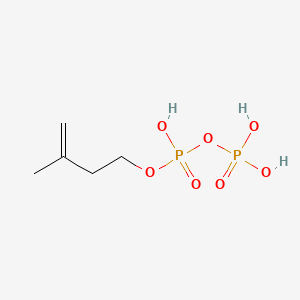| MeSH term | MeSH ID | Detail |
|---|---|---|
| Melanoma | D008545 | 69 associated lipids |
Isopentenyl pyrophosphate
Isopentenyl pyrophosphate is a lipid of Prenol Lipids (PR) class. Isopentenyl pyrophosphate is associated with abnormalities such as Tuberculosis, NAVAJO NEUROHEPATOPATHY and Cryptosporidiosis. The involved functions are known as Signal, Anabolism, T-Cell Activation, T-Cell Proliferation and isoprenoid biosynthetic process. Isopentenyl pyrophosphate often locates in Protoplasm, Host Cell, soluble, Plastids and Cell surface. The associated genes with Isopentenyl pyrophosphate are oxytocin, 1-desamino-(O-Et-Tyr)(2)-, HLA-E gene, RAP1A gene, Gene Family and Orthologous Gene. The related lipids are Steroids, Sterols and isopentenol.
Cross Reference
Introduction
To understand associated biological information of Isopentenyl pyrophosphate, we collected biological information of abnormalities, associated pathways, cellular/molecular locations, biological functions, related genes/proteins, lipids and common seen animal/experimental models with organized paragraphs from literatures.
What diseases are associated with Isopentenyl pyrophosphate?
Isopentenyl pyrophosphate is suspected in Tuberculosis, NAVAJO NEUROHEPATOPATHY, Cryptosporidiosis and other diseases in descending order of the highest number of associated sentences.
Related references are mostly published in these journals:
| Disease | Cross reference | Weighted score | Related literature |
|---|
Possible diseases from mapped MeSH terms on references
We collected disease MeSH terms mapped to the references associated with Isopentenyl pyrophosphate
PubChem Associated disorders and diseases
What pathways are associated with Isopentenyl pyrophosphate
Lipid pathways are not clear in current pathway databases. We organized associated pathways with Isopentenyl pyrophosphate through full-text articles, including metabolic pathways or pathways of biological mechanisms.
Related references are published most in these journals:
| Pathway name | Related literatures |
|---|
PubChem Biomolecular Interactions and Pathways
Link to PubChem Biomolecular Interactions and PathwaysWhat cellular locations are associated with Isopentenyl pyrophosphate?
Visualization in cellular structure
Associated locations are in red color. Not associated locations are in black.
Related references are published most in these journals:
| Location | Cross reference | Weighted score | Related literatures |
|---|
What functions are associated with Isopentenyl pyrophosphate?
Related references are published most in these journals:
| Function | Cross reference | Weighted score | Related literatures |
|---|
What lipids are associated with Isopentenyl pyrophosphate?
Related references are published most in these journals:
| Lipid concept | Cross reference | Weighted score | Related literatures |
|---|
What genes are associated with Isopentenyl pyrophosphate?
Related references are published most in these journals:
| Gene | Cross reference | Weighted score | Related literatures |
|---|
What common seen animal models are associated with Isopentenyl pyrophosphate?
There are no associated biomedical information in the current reference collection.
NCBI Entrez Crosslinks
All references with Isopentenyl pyrophosphate
Download all related citations| Authors | Title | Published | Journal | PubMed Link |
|---|---|---|---|---|
| Fuse M et al. | Regulation of geranylgeranyl pyrophosphate synthase in the proliferation of rat FRTL-5 cells: involvement of both cAMP-PKA and PI3-AKT pathways. | 2004 | Biochem. Biophys. Res. Commun. | pmid:14985133 |
| Fraser PD and Bramley PM | The biosynthesis and nutritional uses of carotenoids. | 2004 | Prog. Lipid Res. | pmid:15003396 |
| Yamashita S et al. | Type 2 isopentenyl diphosphate isomerase from a thermoacidophilic archaeon Sulfolobus shibatae. | 2004 | Eur. J. Biochem. | pmid:15009187 |
| Chojnacki T | Preparation of tritium-labeled 3-methyl-3-buten-1[3H]-yl diphosphate (3H-isopentenyl diphosphate). | 2004 | Meth. Enzymol. | pmid:15038965 |
| Chang SY et al. | Substrate binding mode and reaction mechanism of undecaprenyl pyrophosphate synthase deduced from crystallographic studies. | 2004 | Protein Sci. | pmid:15044730 |
| Burlat V et al. | Co-expression of three MEP pathway genes and geraniol 10-hydroxylase in internal phloem parenchyma of Catharanthus roseus implicates multicellular translocation of intermediates during the biosynthesis of monoterpene indole alkaloids and isoprenoid-derived primary metabolites. | 2004 | Plant J. | pmid:15053766 |
| Dhiman RK et al. | Identification of a novel class of omega,E,E-farnesyl diphosphate synthase from Mycobacterium tuberculosis. | 2004 | J. Lipid Res. | pmid:15060088 |
| Ralph SA et al. | Tropical infectious diseases: metabolic maps and functions of the Plasmodium falciparum apicoplast. | 2004 | Nat. Rev. Microbiol. | pmid:15083156 |
| pmid:15110773 | ||||
| Kalyan S and Chow AW | Human peripheral gammadelta T cells potentiate the early proinflammatory cytokine response to staphylococcal toxic shock syndrome toxin-1. | 2004 | J. Infect. Dis. | pmid:15122526 |
| Glazko GV and Mushegian AR | Detection of evolutionarily stable fragments of cellular pathways by hierarchical clustering of phyletic patterns. | 2004 | Genome Biol. | pmid:15128446 |
| Chau M and Croteau R | Molecular cloning and characterization of a cytochrome P450 taxoid 2alpha-hydroxylase involved in Taxol biosynthesis. | 2004 | Arch. Biochem. Biophys. | pmid:15178487 |
| pmid:15196010 | ||||
| Kunzmann V et al. | Polyinosinic-polycytidylic acid-mediated stimulation of human gammadelta T cells via CD11c dendritic cell-derived type I interferons. | 2004 | Immunology | pmid:15196204 |
| pmid:15197467 | ||||
| Laupitz R et al. | Biochemical characterization of Bacillus subtilis type II isopentenyl diphosphate isomerase, and phylogenetic distribution of isoprenoid biosynthesis pathways. | 2004 | Eur. J. Biochem. | pmid:15206931 |
| Poliquin K et al. | Inactivation of sll1556 in Synechocystis strain PCC 6803 impairs isoprenoid biosynthesis from pentose phosphate cycle substrates in vitro. | 2004 | J. Bacteriol. | pmid:15231801 |
| Verjans GM et al. | Isopentenyl pyrophosphate-reactive Vgamma9Vdelta 2 T helper 1-like cells are the major gammadelta T cell subset recovered from lesions of patients with genital herpes. | 2004 | J. Infect. Dis. | pmid:15243921 |
| pmid:15257386 | ||||
| pmid:15279616 |
